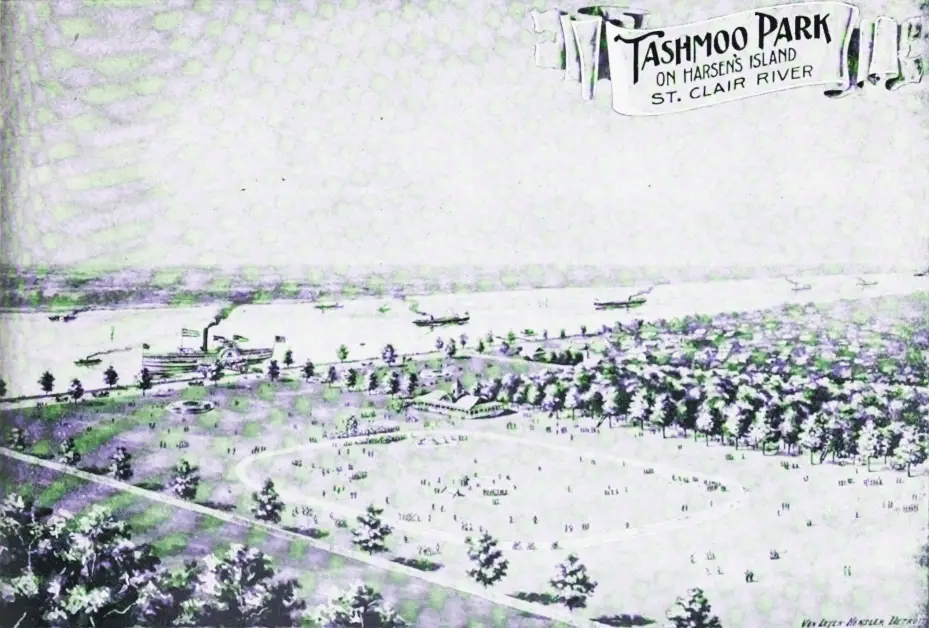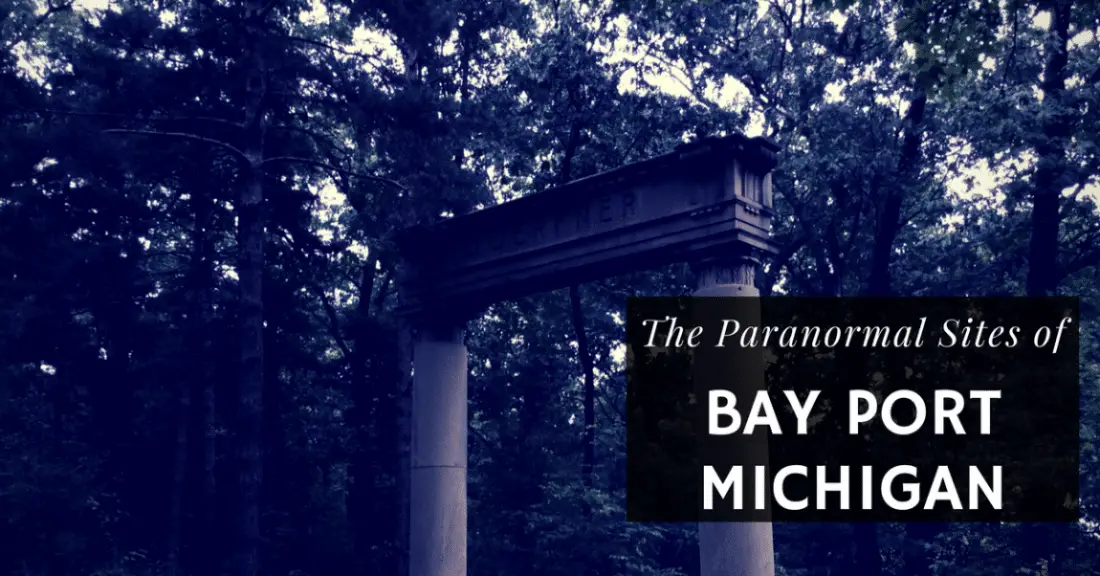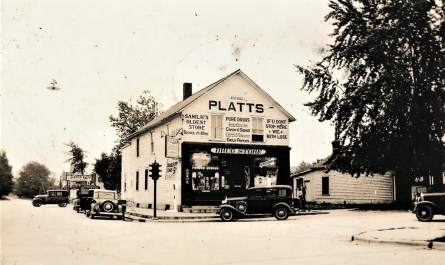Harsens Island, nestled in the St. Clair River Delta, is rich in history and natural beauty. This tranquil island has been a popular boating, fishing, and relaxation destination for over a century. Among its many historical gems, the Harsens Island Tashmoo Park is a remarkable chapter in the island’s past. The park operated from 1897 until 1951.
Table of Contents
What Does Tashmoo Mean?
Established in the late 19th century, Tashmoo Park was more than just an entertainment venue; it was a significant part of Detroit culture and a beloved destination for many Michiganders. Its name, “Tashmoo,” is believed to have Native American origins, reflecting the area’s deep cultural roots. The word “Tashmoo” is thought to mean “meeting place” or “gathering place,” fitting for an amusement park that brings together people from all walks of life for fun and recreation. However, there is also a Lake Tashmoo on Martha’s Vineyard.
The park’s history is filled with thrilling steamboat rides, grand hotels, notable visitors, and mysterious tales. From its inception, through its golden years, to its eventual decline and the lingering legacy it left behind, Tashmoo Amusement Park is a fascinating story waiting to be told.
The Birth of Harsens Island Tashmoo Park
The Harsens Island Tashmoo Park was established in 1897 during the rise of amusement parks as popular leisure destinations. Tashmoo Park, opened by the White Star Line, featured a casino, dance pavilion, roller rink, recreation center, and sports area. In 1899, the company introduced the Tashmoo, a grand 306-foot steamship, the largest paddle-wheeled steamer on the lakes, capable of accommodating 3500 passengers. The park was envisioned as a retreat for families and tourists to escape city life and enjoy a day of fun on Harsens Island.
From its inception, Tashmoo Park featured a variety of attractions designed to captivate visitors of all ages. The early attractions included a grand dance pavilion, picnic areas, and a beautiful botanical garden. The park also boasted a merry-go-round and other playground equipment that provided thrilling experiences for youngsters.
Tashmoo Park provided a welcome retreat from Detroit’s stifling summer conditions. It offered picnic areas, a baseball diamond, and large open spaces to stroll and play. Visitors could also enjoy swimming in the nearby St. Clair River and purchase moccasins and beadwork from local Indians of Walpole Island.
Where Was Tashmoo Park Located?
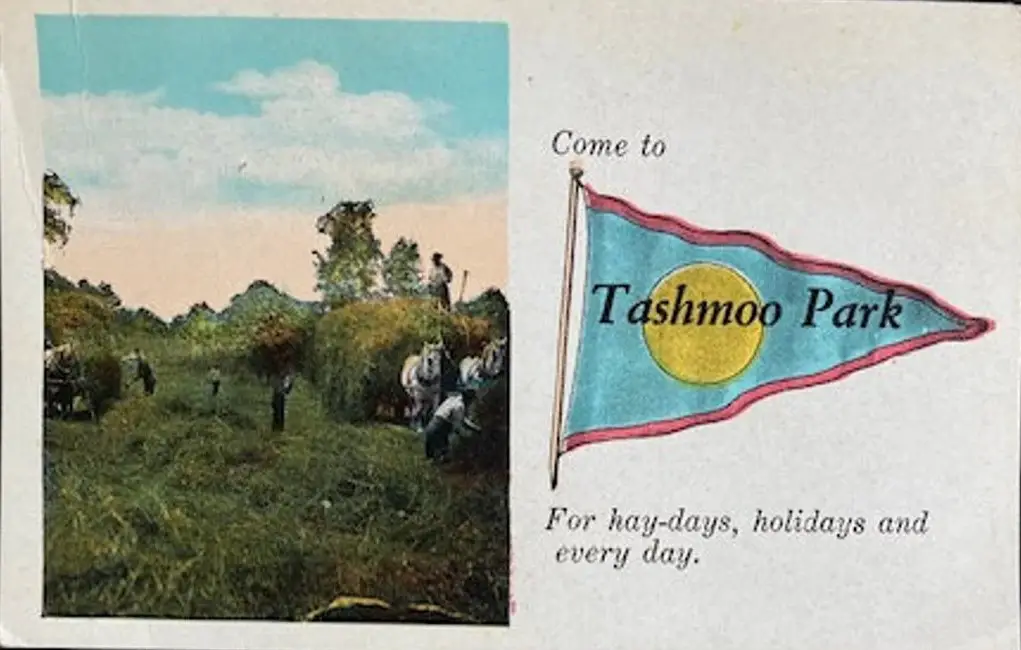
Tashmoo Park was located on the southwestern shore of Harsens Island in the St. Clair River Delta, Michigan. The park was accessible primarily by steamer, ferrying visitors from Detroit and nearby areas. This scenic location, surrounded by water, contributed to its nickname, “Venice of the Midwest,”
A key feature of the park was its accessibility. Located along the Detroit River, Tashmoo Park was easily reachable by steamboat, making it a popular excursion destination. The steamer Tashmoo, which the park was named after, transported thousands of eager visitors from Detroit and surrounding areas to the park, contributing to its early success.
The park quickly became a beloved destination, known for its festive atmosphere and diverse entertainment options. Families could spend an entire day enjoying rides, games, and outdoor activities. The early years of Tashmoo Park set the stage for its emergence as a major attraction in Michigan, laying the foundation for its golden era in the years to come.
Golden Era of Harsens Island Tashmoo Amusement Park
The early 1900s marked the golden era of Harsens Island Tashmoo Park. During this period, the park was at the height of its popularity, drawing visitors from across Michigan and beyond. Tashmoo Park’s allure lies in its wide range of attractions and idyllic setting on Harsens Island.
Peak Years of Operation At Tashmoo Park
Tashmoo Park thrived in the first few decades of the 20th century, with its peak years spanning from the early 1900s to the late 1920s. Visitors visit the park for its exciting rides, scenic picnic spots, and vibrant entertainment options. The park’s roller coaster, one of its main attractions, was a thrilling ride that provided endless excitement for those brave enough to take the plunge.
Popular Attractions and Events At Tashmoo
Tashmoo Park wasn’t an amusement park per se. It was an event park that offered wide spaces and pavilions for company picnics and events. However, there was a casino, picnic area, recreation center, roller skating rink, and sports center. The merry-go-round, with its beautifully crafted horses and lively music, was a favorite among children and adults. The park also featured a dance hall that offered music all day for free and various games that entertained visitors.
The Venice of the West
Tashmoo Park on Harsens Island was called the “Venice of the Midwest” due to its picturesque setting along the St. Clair River. It features numerous waterways, canals, and natural beauty resembling Venice, Italy’s famed canals. The park’s accessibility by steamer and its idyllic, water-surrounded location contributed to this romantic nickname, making it a unique and attractive destination for visitors seeking leisure and entertainment amidst scenic views.
The Steamer Tashmoo
The steamer Tashmoo was launched in 1900 and was a celebrated vessel on the Great Lakes. Known as the “White Flyer of the Lakes,” it was famed for speed and elegance. The steamer could carry over 3,500 passengers and was crucial in ferrying visitors to Tashmoo Park. It boasted luxurious interiors and was a marvel of engineering, often breaking speed records on its trips between Detroit and Port Huron.
Route of the Tashmoo Steamer From Detroit

For more detailed information, visit the Historic Detroit page on the Tashmoo.
The Story of the Message in a Bottle Mystery
One of the intriguing stories from Tashmoo Park’s golden era is the mystery of the message in a bottle. In 1915, two young women, Selina Pramstaller (17) and Tillie Esper (23), tossed a bottle containing a note into the St. Clair River from the Tashmoo Steamer. The note, written in pencil, said they were “having a good time at Tashmoo.” Diver Dave Leander found the bottle 97 years later, buried in 30 feet of water. The note included the women’s addresses in Detroit. Efforts are underway to locate their descendants. The bottle was originally used for cherries or olives and had a White Star Line deposit ticket as the note paper.
For more details, visit the full story.
The Grande Pointe Hotel
The Grande Pointe Hotel on Harsens Island was a prominent luxury hotel in the early 1900s. It offered guests elegant accommodations, fine dining, and a range of recreational activities. The hotel’s prime location near Tashmoo Amusement Park made it a popular choice for visitors seeking a comprehensive vacation experience. The hotel was known for its beautiful architecture, well-manicured grounds, and excellent service, contributing to Harsens Island’s reputation as a premier resort destination during that era.
President Teddy Roosevelt’s Visit in 1902
A notable highlight of Tashmoo Park’s golden era was President Theodore Roosevelt’s visit in 1902 In the autumn of 1902, President Theodore Roosevelt set out on an extensive western tour by train to support Republican candidates for the upcoming election. The President’s visit brought national attention to the park and the island, boosting its popularity and prestige. Roosevelt’s presence on the Tashmoo steamer underscored its importance as a premier destination and added a significant chapter to its history.
Challenges and Decline At Tashmoo Park
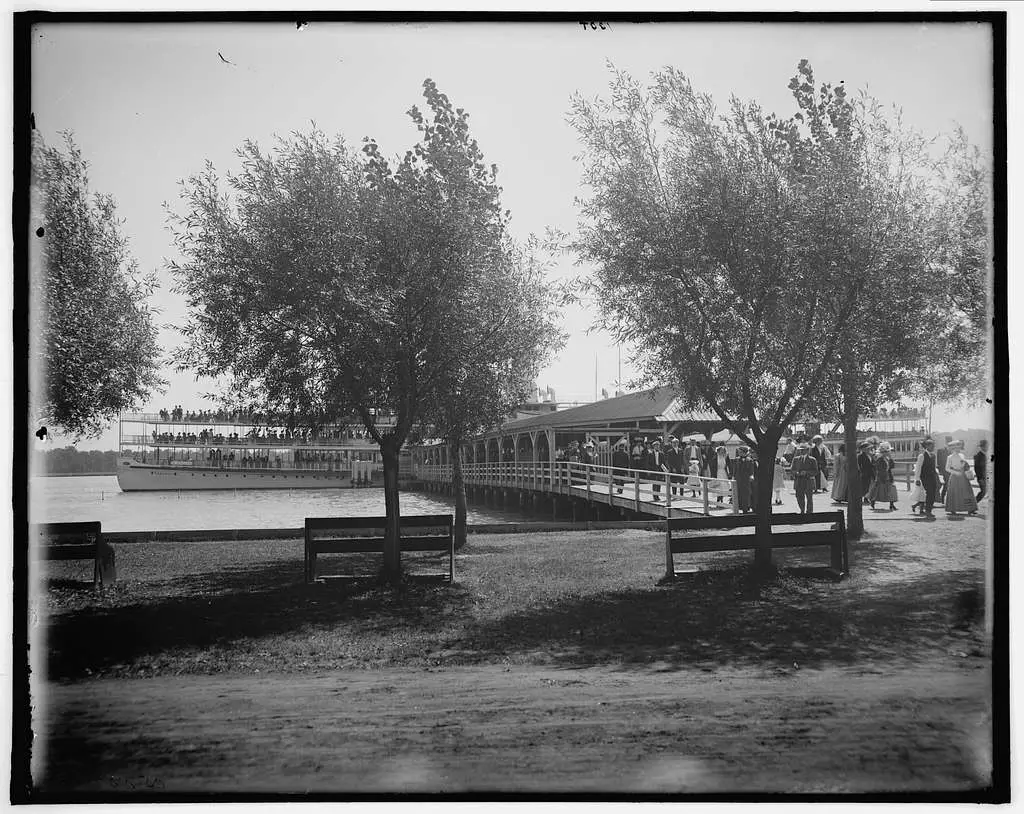
The latter part of the 20th century brought significant challenges to Harsens Island Tashmoo Amusement Park. Economic and social changes, combined with external events, eroded the park’s once-thriving status.
Economic and Social Factors Leading to Tashmoo Decline
The park faced numerous economic challenges as the Great Depression occurred in the 1930s. The economic downturn reduced disposable income, leading to fewer visitors and declining revenues. Additionally, social changes, such as the rise of the automobile, allowed families to explore other recreational destinations, diminishing Tashmoo Park’s exclusive appeal.
Changes in Management and Ownership
Frequent changes in management and ownership added to the park’s troubles. These transitions often brought shifts in vision and strategy, sometimes leading to inconsistencies in the park’s operations and offerings. The lack of a stable, long-term plan made it difficult for Tashmoo Park to adapt to the changing times and maintain its competitive edge.
Impact of the Great Depression and World War II
The Great Depression severely impacted the park, causing financial strain and a decline in visitor numbers. World War II further exacerbated these issues as resources and public attention shifted toward the war effort. Many amusement parks nationwide struggled during this period, and Tashmoo Park was no exception. The combined effects of the economic downturn and wartime challenges contributed significantly to the park’s decline.
The Park’s Attempts at Revival
Despite the difficulties, there were several efforts to revive Harsens Island Tashmoo Park in the years following World War II. These attempts aimed to restore the park to its former glory and recapture the magic that had once made it a beloved destination.
Efforts Made to Revive the Park Post-WWII
In 1936, the steamer Tashmoo sank after hitting a rock near Amherstburg, Ontario. After World War II, the park was still open for visitors who arrived by car and gained entry for 75 cents. Concerted efforts were made to breathe new life into Tashmoo Park; however, the park just wore out and was closed in 1946.
Notable Events and Changes During These Attempts
After it closed, the buildings remained. A scavenger wreaked havoc on the abandoned park. In 1990, the hand-carved animals on the carousel were sold at auction at Chistes Auction House in New York City. In 1997, local residents of Hasen’s Island placed a historical marker at the site to commemorate the park’s 100th anniversary.
However, the legacy of Harsens Island Tashmoo Park continues to be remembered fondly by those who visited during its heyday. Despite the decline and unsuccessful revival efforts, the park remains an integral part of Michigan’s history, reflecting the changing dynamics of recreation and community over the decades.
Legacy and Remnants Of Tashmoo Park
Despite its decline, the legacy of Harsens Island Tashmoo Amusement Park endures in the memories of those who experienced its charm and excitement. The park’s history is preserved through various efforts and personal stories, ensuring that its significance is not forgotten.
What Remains of the Amusement Park Today
Today, a few remnants of Tashmoo Amusement Park remain on Harsens Island. Although many of the original structures have been lost to time, traces of the park’s existence linger as Tashmoo Marina. The vast ballfields and track are now a working boatyard. The dance pavilion is now an inside winter storage for boats. The old foundations, pathways, and other artifacts are now part of the marina’s landscape on the St. Clair River.
Preservation Efforts and Historical Significance
Efforts have been made to preserve the history of Tashmoo Park through local historical societies and preservation groups. These organizations work to document and share the park’s story, ensuring that future generations can appreciate its cultural and historical importance. The park’s history is also celebrated through photographs, postcards, and memorabilia that capture the spirit of Tashmoo in its prime.
FAQs About Tashmoo Park
Where was Tashmoo Amusement Park located?
Tashmoo Amusement Park was situated on the southwestern shore of Harsens Island in the St. Clair River Delta, Michigan. It was primarily accessible by steamer, making it a popular destination for visitors traveling from Detroit and other nearby areas.
Why was Harsens Island called the “Venice of the Midwest”?
Harsens Island earned the nickname “Venice of the Midwest” due to its scenic waterways, canals, and natural beauty that resembled Venice, Italy. The picturesque setting, coupled with the steamer rides to Tashmoo Park, enhanced its appeal as a unique recreational destination.
What was the significance of the Oakland Hotel on Harsens Island?
The Oakland Hotel was a luxurious establishment that provided elegant accommodations and fine dining for visitors to Harsens Island, including those visiting Tashmoo Park. Its presence contributed to the island’s reputation as a premier vacation destination in the early 20th century.
Video: Moment in History’s, Museum Mysteries: Ep.6 Tashmoo Park
Amusement Parks in Michigan
| Amusement Park | Location | Years of Operation |
| Edgewater Park | Detroit | 1927 – 1981 |
| Boblo Island Amusement Park | Bois Blanc Island (Boblo Island) | 1898 – 1993 |
| Michigan’s Adventure | Muskegon | 1956 – present |
| Jefferson Beach | St. Clair Shores | Early 1900s – 1925 |
| Eastwood Park | East Lansing | 1916 – 1962 |
| Walled Lake Amusement Park | Walled Lake | 1929 – 1968 |
| Oakwood Amusement Park | Kalamazoo | 1907 – 1949 |
| Deer Forest Fun Park | Coloma | 1949 – 2018 |
| Tashmoo Amusement Park | Harsens Island | 1897 – 1951 |
| Jefferson Beach Amusement Park | St. Clair Shores | 1927 – 1959 |
| Electric Park | Detroit | Early 1900s |
| Liberty Park | Sterling Heights | 1985 – 2004 |
This table briefly overviews some of the amusement parks that have been part of Michigan’s recreational history.

